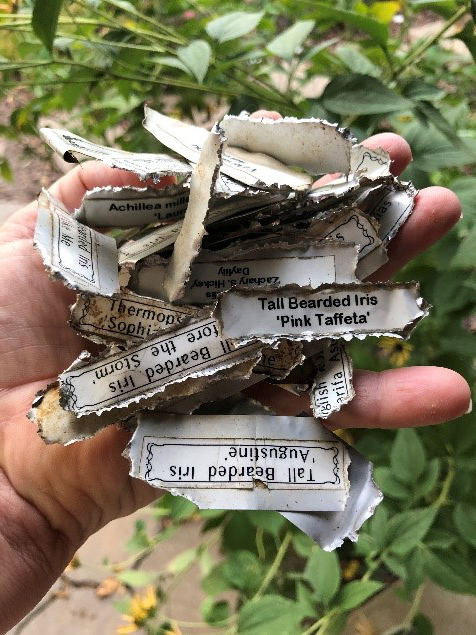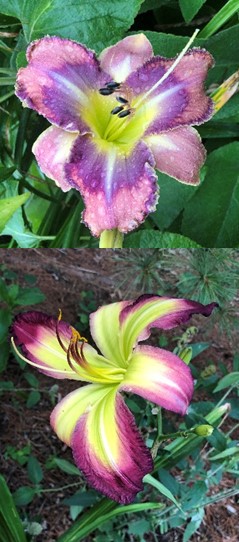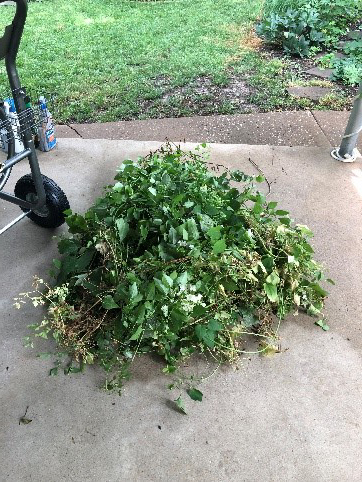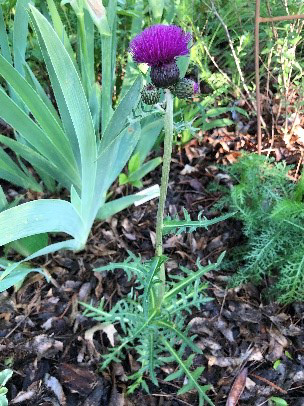Past mistakes seem to come back and bite you. When I started planting my garden nearly 19 years ago, I didn’t think to keep a master list of my plants mainly because I didn’t know then how much I would come to rely on it for accurately identified photo images. For the first five years, I just labeled my plants with a handheld label maker, with no connection to a database. Then I finally wised-up and started logging my plants in an Excel file and printing labels with a label maker that could print from a merge file. It never really bothered me that my oldest plantings weren’t in the database because everything was still labelled. Now I’m paying for that oversite. Who knew my golden retriever’s favorite puppy prank was to rip up and chew as many tags in oblivion as she could before I could grab her. She alone is responsible for totally destroying about 100 tags. Then, in the last two years, chipmunks have specifically targeted the tags I happened to be using those first five years to sharpen their little rodent teeth. I have recovered hundreds of partially chewed tags, but just as many have been totally destroyed or are yet to be found. Since I don’t have a complete list, relabeling without knowing all the possibilities is sometimes an effort in futility. Over and over again I see a plant in bloom, only to find it doesn’t match anything on my master list. Naturally it has to be a plant whose tag was destroyed or hasn’t been found yet…and I just happen to have never taken a picture of it either. It then occurred to me I had kept all my plant labels and receipts over the years and those could be used to cross reference and complete my list. My husband asked me why I had kept them (probably sounded pretty crazy to him), and I really had no answer other than I’m glad I did. So, whenever it’s too hot or too rainy to be in the garden, I just grab a few handfuls of labels and start updating the list. It will take me weeks if not months to get through them all, but the joy of identifying something thought lost is well worth it.
Who knew a plant stereotype could result in a plant’s death, but that’s exactly what happened recently in my garden. My mom thought she was really doing something by removing a “horrible vining weed” from the oakleaf hydrangea in the front yard. And I was impressed for the amount of work it must have taken her, because it was a rather large vine. Unfortunately it was a sweet autumn clematis (Clematis terniflora) I was using the hydrangea for as its trellis. Mom’s stereotype is good vines grow on a man-made trellises; bad vines grow on other plants, choking the life out of them.
During lunch the next day, we were still laughing about her “taking out” a clematis, when my husband commented he’s afraid to remove anything from the yard because he doesn’t know a weed from a desirable plant. ‘’For example, there’s a thistle plant in the front yard that looks like a weed, but Liz tells me it’s not.” My mom say’s “look out the window.” I look out the window and see a blank space, realizing another plant has met its end because of a stereotype, LOL. This time Cirsium rivulare 'Trevor's Blue Wonder'. Mom’s stereotype is all thistles are aggressive weeds, not knowing there are non- aggressive ornamental clumping types. Well, I know where I can get another to replace it.
When I told Mom I was including her recent plant murders in the newsletter, she thought it was only fair that I include something my husband does counter to my wishes in the garden too. Well okay, he is not always careful about where he drops a limb, sometimes crushing or maiming a plant. I sure have killed my share of plants by various methods over the years, so I can’t be mad about other’s mistakes. And to be honest, there really is no place to drop a limb where it won’t fall on something. It’s all part of the gardening learning process, and no matter what, I’m glad I have family to share it with.



